Wyandotte chickens are an American breed developed in the 1870s in New York. They were created by crossing several breeds of chickens. The Wyandotte was bred to be a utility bird, and it quickly became a popular choice for farmers due to its high egg production and ability to withstand cold climates.
Are you wondering if Wyandotte chickens (Golden Laced Wyandotte) might be the right breed for you and your backyard flock? This post will cover everything you need to know about Wyandottes, from their history and appearance to their personality and egg production. We’ll also touch on their cold hardiness and chicken coop needs. By the end, you should know whether Wyandottes are the right breed of chicken for your homestead.
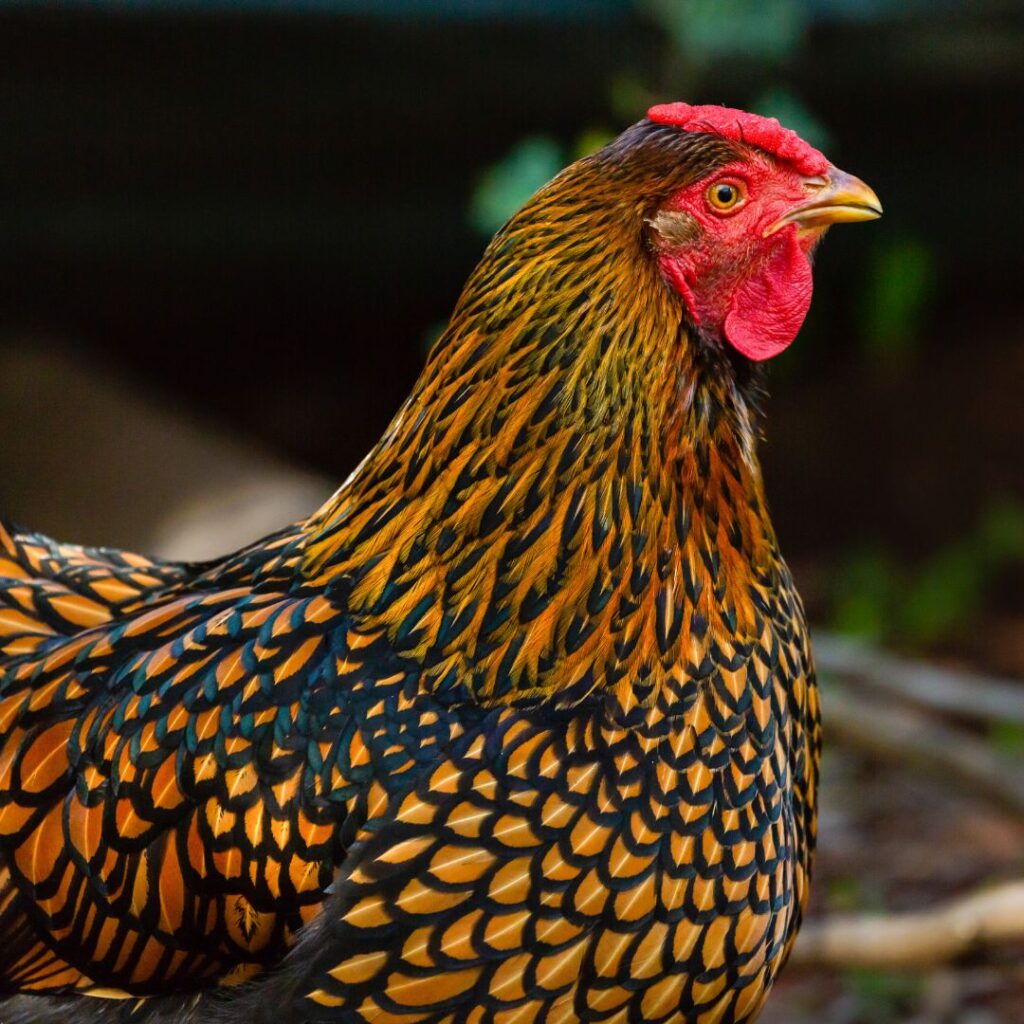
Wyandotte: The History
The Wyandotte chicken breed was first developed in the U.S. in the 1870s by four individuals: H. M. Doubleday, John Ray, L. Whittaker, and Fred Houdlette. The initial type of Wyandotte was the silver-laced variety, which was recognized by the American Standard of Perfection in 1883 and also taken to Britain around that time.
While the exact origins of this breed are still somewhat unclear, different breeds – silver-spangled Hamburgs and dark Brahmas are thought to have been essential breeds used in its creation.
Before being given their current name, these chickens were referred to as “Sebright Cochin” and “American Sebright.” Today, Wyandottes are famous for their excellent egg-laying abilities and distinctive appearance with beautiful feather patterns.
The Wyandotte is admired for its hardiness and maternal instincts as a layer and a mother hen. Its rich coloration and impressive physical characteristics make it a favorite among farmers and poultry enthusiasts.
How Do You Say It? wyandotte pronunciation
Read all about the Sebright bantam breed here and The Mille Fleur D’Uccle Here
Read More About Cochin Chickens Here.
The History of The Golden-Laced Wyandotte
Joseph McKeen first created the beautiful Golden Laced Wyandotte chicken in Wisconsin in the late 1800s. He started his project by crossing Silver Laced Wyandottes with a bird called a Winnebago and continued to perfect his creation until it was officially accepted into the American Poultry Association in 1888
Golden-Laced Wyandotte Breed Standard and Appearance
This vibrant breed has gold feathers delicately laced with black, giving them a stunning appearance. In addition to their dazzling looks, the Golden laced Wyandotte is also known for its bountiful body size and shape, sporting deep breasts and broad bodies. They have clean legs, four toes, yellow skin, red wattles and earlobes, and a rose comb on top of their broad skulls. If you’re looking for both beauty and utility in your flock, the Golden Laced Wyandotte is an excellent choice.
gold laced wyandotte rooster vs hen
Golden Laced Roosters typically weigh around 8-9lb, while hens usually weigh 6-7lb. Bantams weigh approximately 2 1/4 pounds for females and 2 1/2 pounds for males.
What do Golden Laced Wyandotte baby chicks look like?
These charming little baby chicks start with fluffy down feathers covering their brown and black bodies. As they mature, they develop a beautiful golden lace pattern on their wings and tails. Their breast and head are typically brown or grayish, making for a unique and eye-catching appearance.
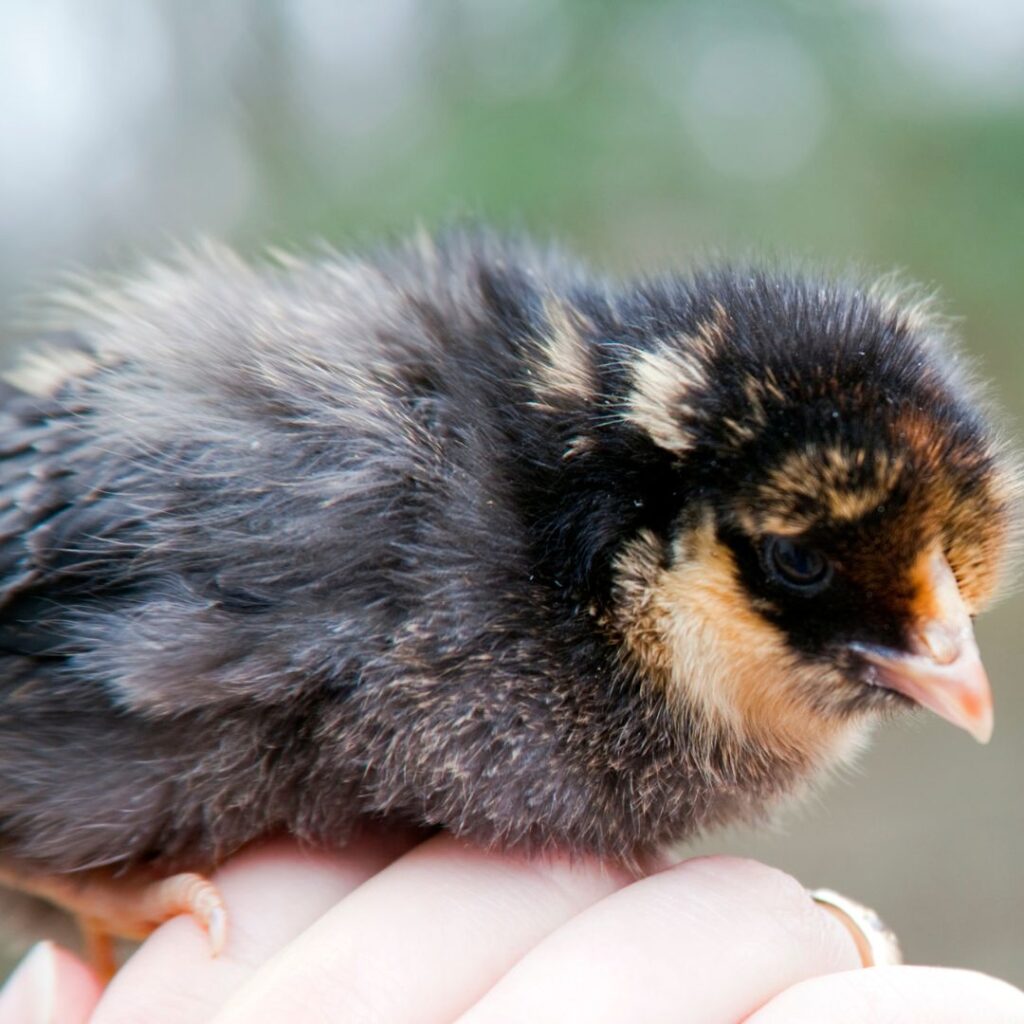
enjoy more gold laced Wyandotte chicks pictures in this video below
Breed Variations of the Golden-Laced Wyandotte
If you’ve ever stumbled upon a flock of Wyandottes at a poultry show, you might have been struck by the beautiful array of colors they come in. From sleek black feathers to eye-catching golden-laced plumage, Golden laced Wyandottes, and other color varieties are known for their stunning visual variety.
So, whether you prefer to add some striking color to your backyard coop or are looking for a potential champion at competitions, there’s sure to be a Wyandotte that catches your eye.
The American Poultry Association’s Standard of Perfection recognizes nine colors, including bantam varieties for those who prefer smaller birds. The Bantam breed also includes the buff Columbian.
So Many Color patterns!
Besides the Silver and Golden Laced Wyandottes, there are seven other breed variations of this chicken.
Black 1893
Black Feathers
Blue 1977
Bluish, Silvery Gray Feathers
Buff 1893
Light golden, ‘buff’ colored feathers
Columbian 1905
While creating a new type of chicken may not seem like a momentous occasion, the history of the Columbian Wyandotte is quite fascinating. These birds resulted from an accident in 1883 when white Wyandottes were accidentally crossed with barred Plymouth Rock birds. They were unveiled at the famous Columbian Exposition in 1893. Next time you spot a Columbian Wyandotte, remember that it’s more than just a pretty face – it’s also a testament to the happy accidents that can occur in breeding.
Golden Laced Wyandottes 1888
The golden-laced Wyandotte breed of chicken is known for its distinctive gold feathers with black outer edges, giving them their unique and striking appearance.
Partridge 1893
Have you ever seen a Partridge Wyandotte? This unique breed of chicken was developed through crossbreeding in the mid-1800s. It was created by combining the Gold-laced Cochin, Partridge Cochin, Gold-pencilled Hamburgh, and Winnebago strains. The result is a fascinating combination of color and feathers, with its trademark feathers. Its body is round and compact, with a broad chest and well-fitted tail (a trait it inherited from the Indian Game).
Silver Laced Wyandottes
The silver-laced wyandotte chicken breed is identified by its striking silver feathers with black outer edges.
Silver Penciled 1902
The Silver Penciled Wyandotte is a rarity in the world of poultry. These elegant birds boast impressive plumage, with silver feathers marked by multiple thin dark pencil lines that follow the shape of each feather. These beautiful color variations are hard to come by, making Silver Penciled Wyandottes highly sought after by breeders and show enthusiasts.
It’s important to note that these intricate markings only appear at maturity.
White 1888
Note: as in the APA breed standard of the Golden Laced Wyandotte, these color variations share common traits such as its clean, yellow legs and four toes, red rose comb, and rounded body type.
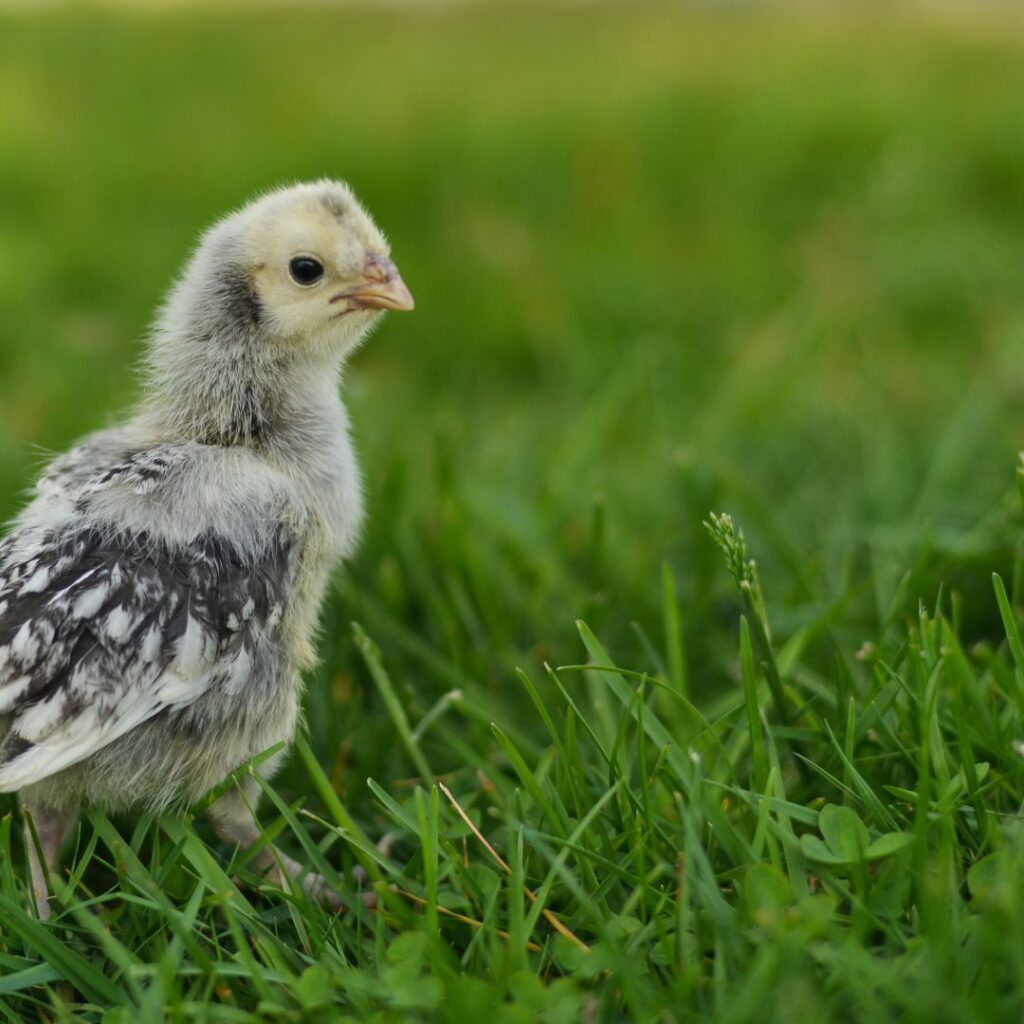
Personality Of A Golden-Laced Wyandotte Chicken
The Wyandotte is known for its calm, docile demeanor, making it an excellent choice for chicken enthusiasts who want friendly and low-maintenance birds.
However, don’t let this fool you – the Wyandotte also has a streak of assertiveness that allows it to handle itself in the pecking order. They tend to keep to their own group rather than mingle with other breeds, showing their dominant nature. While they may not start fights, the Wyandotte will not tolerate being pushed around by more aggressive birds.
Ultimately, this assertiveness helps make them strong leaders in the coop hierarchy, ensuring harmony and balance within the flock. Overall, Wyandotte’s strengths lie in its peaceful yet assertive nature, making it a well-rounded choice for any chicken owner.
Are the Wyandotte Friendly Birds?
While the Wyandotte is a docile and, yes, a confident bird, allowing them to hold their own around small children, this doesn’t make for a ‘cuddly’ pet chicken. Like some chickens, you won’t find many Wyandottes sitting on your lap.
As with other chickens, we always suggest ‘handling’ your gold-laced Wyandotte by patting them and picking them up (from a safe height) now and then. This will help your bird be more comfortable with being touched by human hands, which can be a big plus if you need to inspect them for injury or even more exciting for show.
Are Golden-Laced Wyandotte Roosters Aggressive?
Like any rooster, the Wyandotte rooster will hold his own with the flock and not tolerate any other males in the nearby proximity of a small flock. They won’t go looking for a fight, but they are known for being at the top of the pecking order, so when adding other chicken breeds to your flock, stick with larger and more confident hens.
Adding a 2nd gold laced rooster should be (only) if you have 9 (we’d suggest more in this case) or more hens in your flock.
Golden Laced Wyandotte Hens; Egg Production
If you’re looking for a dependable egg producer, look no further than the Wyandotte chicken. This breed is known for its high productivity, with each bird laying an average of 200-250 eggs annually.
When do they start laying eggs?
Larger breeds like Wyandottes, Barred Plymouth Rocks, and Orpingtons are a great choice. These breeds can start laying a little closer to 6 to 8 months. It’s always best to prepare for the occasional over-performer that starts earlier. Have those nesting boxes ready and in good repair; your hens will be laying for quite a few years.
What color and size eggs are Wyandotte Eggs?
Large brown eggs
How many eggs do Wyandottes Lay?
200-250 eggs per year
Find out more about other chickens that are great egg layers here.
Meat Birds; dual purpose breeds
The Golden laced Wyandotte chicken (as well as other variations) is not only gorgeous and hardy but excellent as a dual-purpose bird, meaning not just eggs but also table birds. The size of the roosters at maturity (8 – 9 pounds) is perfect for most families.
Read about our favorite Dual Purpose Chicken, the Cornish.
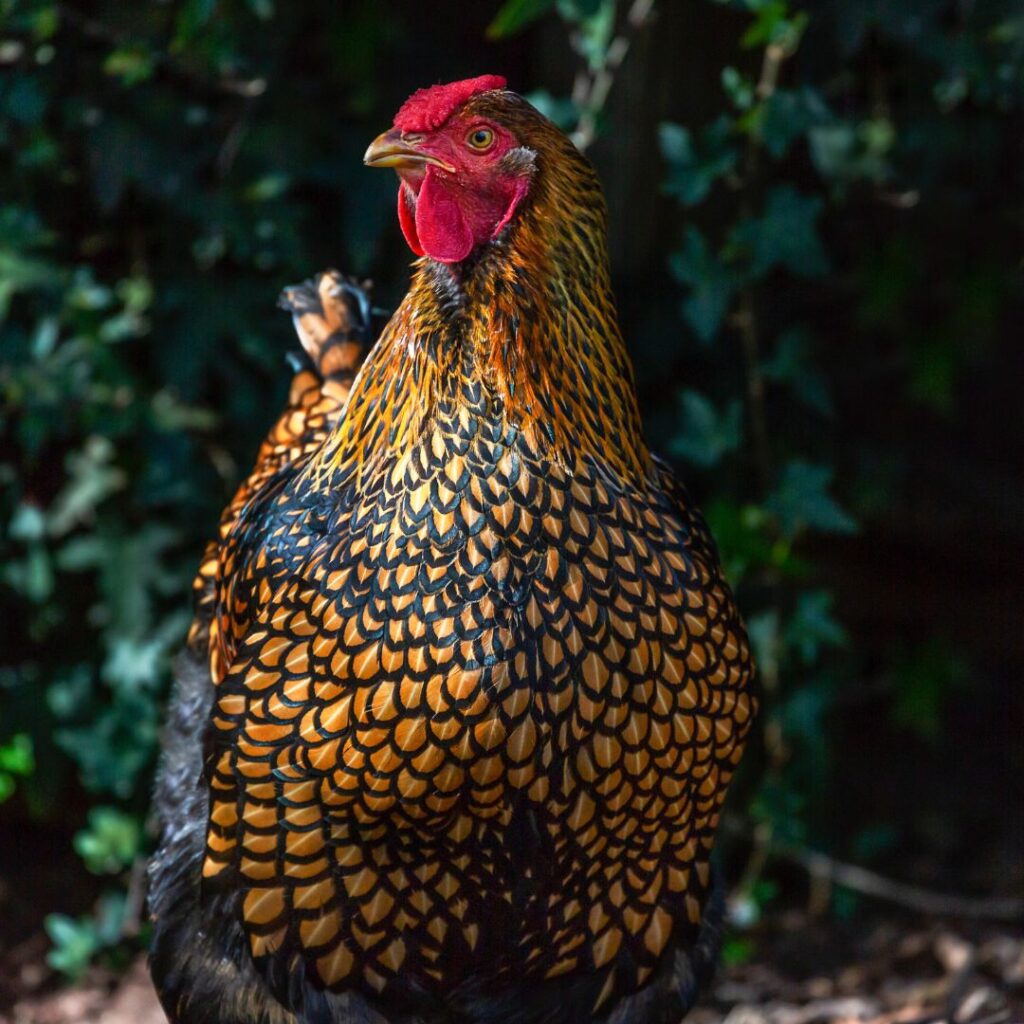
The Chicken Coop Needs for Wyandotte Chicken Breed
Being from large breeding stock, the gold-laced Wyandotte hens can take up a decent amount of space with even a small flock, so plan accordingly. Always remember your future flock plans and count on having an ‘extra’ space as your flock increases.
Space – When raising happy and healthy chickens, one of the most critical factors is inside coop space. The minimum recommendation for Wyandottes is 10 square feet per bird, which applies even if you have a mixed flock. It’s important to remember that larger breeds like Jersey Giants and Brahmas need extra space, so be sure to adjust accordingly.
Though Wyandottes are excellent at foraging, they still need enough room indoors to move freely. This will help to avoid behavior and health problems. Providing adequate coop space is key to keeping your flock happy and thriving.
Perch – Wyandottes are a big breed. It is beneficial to place their roosts 12-18 inches from the ground, so they do not hurt themselves when hopping off the perch.
Roosts should be 8-10 inches wide to allow each chicken enough space to roost comfortably. During the warm summer, your golden wyandottes will spread out a bit, so leave that extra space. During winter, your chickens will huddle together to stay warm.
Nesting boxes – The Golden laced Wyandotte chicken is a larger breed, so it’s important to ensure they have a spacious nesting box to lay their eggs in comfortably. The recommended size for each box is at least 12 inches deep and wide, and it’s also helpful to add extra bedding for cushioning. A good rule is to have one nesting box for every four chickens so they all have enough room to lay without competing or searching for space. Providing enough nest boxes can result in your hens laying their eggs in unsafe or unprotected places, leaving them vulnerable to being stepped on or broken. Make sure your Wyandottes have enough room to lay comfortably, and your egg-gathering routine will be much easier.
Feeders and Waterers – As a chicken owner, it’s important to ensure your flock of chickens always has access to clean water and fresh food. Depending on the size of your waterers and the number of chickens, they may need to be filled frequently. Larger bird breeds like the Wyandotte have bigger appetites and will require more food, so make sure your feeders can hold enough for all of your chickens.
It’s best to hang the feeders about 8 inches off the ground to allow for easy access and prevent pests from getting into the food. Need a hanging feeder? A simple bowl can work as a temporary solution until you get a proper one.

The Chicken Run For Your Wyandotte Chicken
Outdoor Pen Space (aka the ‘run’) – When it comes to chickens, having enough room to roam is crucial for their physical and mental well-being. It’s important to note that each large breed chicken’s recommended amount of run space is 10-15 square feet. Too little space can lead to moodiness and aggression within your flock, resulting in pecking and injuries.
On the other hand, providing ample space will encourage natural behaviors such as foraging and dust bathing, leading to happier and healthier chickens. So when planning out your coop and run set-up, make sure you have enough room for all of your feathered friends to roam freely. Your chickens (and you!) will thank you.
Shelter from elements – It’s also crucial to make sure this area has a safe place for them to escape inclement weather. A tarp or leaning piece of wood can easily provide some coverage from rain or snowfall. This covered section allows the birds to enjoy the outdoors while still being protected from harsh elements. Plus, the added shelter can help keep predators at bay as well.
Fencing height – When it comes to keeping your chickens safe from predators, one important aspect to consider is the height of your fence. A fence at least six feet tall will deter most chicken breeds from trying to jump or flutter over and discourage potential predators from entering the run area.
However, if you live where there is a population of hawks, you should take extra precautions by covering the run area with hardware cloth. While hawks are unlikely to target a larger breed like a golden-laced wyandotte, it’s always better to avoid caution when protecting your feathered friends. Taking these measures can ensure that your chickens live happy and healthy lives.
Dust Bath – When it comes to keeping your chickens healthy, a dust bath should be considered a necessity. Not only does it allow them to rid themselves of pesky lice and mites, but it can also provide an enjoyable activity for your feathered friends.
While some opt for indoor dust baths, we prefer setting up an outdoor area filled with dry dirt or sand. Adding products like diatomaceous earth and dried herbs can enhance the bath’s effectiveness even further.
Remember to monitor the condition of the dust bath and replenish it as needed – happy chickens lead to a happy flock. Get those dust baths set up and watch your chickens thrive.
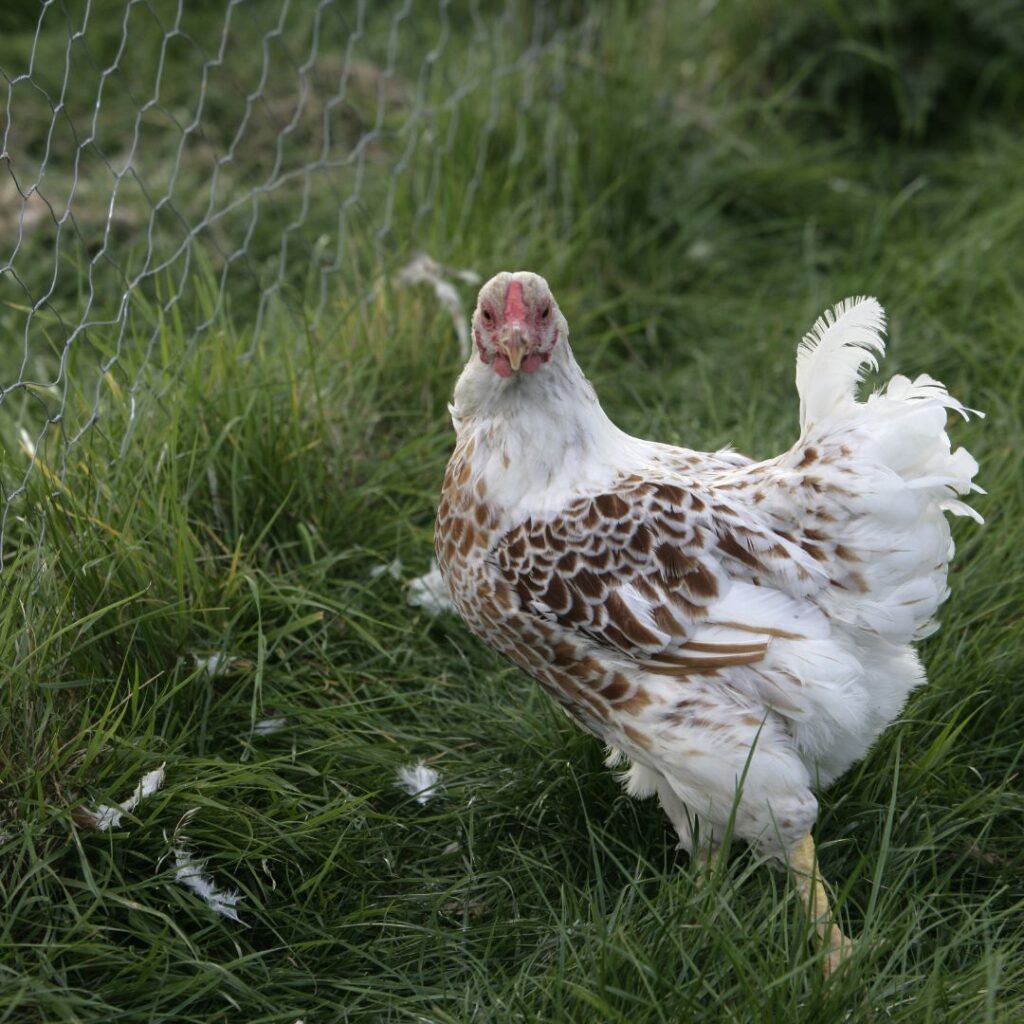
Free-Range and Foraging; Golden-Laced Wyandotte Chicken
If you’re looking for a versatile poultry option for free-ranging, Wyandotte hens and roosters should be on your radar. They can forage in various habitats, including open fields and wooded areas.
Wyandottes aren’t picky eaters – they will scratch through leaves and underbrush to find a variety of food sources, such as insects. This makes them a great choice for those with multiple types of land or varying free-ranging options.
Just make sure to leave their coop or outdoor run space with an open door, so they can easily come home at the end of the day.
Overall, Wyandottes are a great option for those seeking a hardworking and adaptable addition to their free-ranging flock.
Are the Golden-Laced Wyandotte Good Urban (City) Chickens?
If you can contain your flock in a large area, you may get away with city noise laws, but overall this bird may be a risk for city (urban) flock owners as it can get quite noisy with limited space.
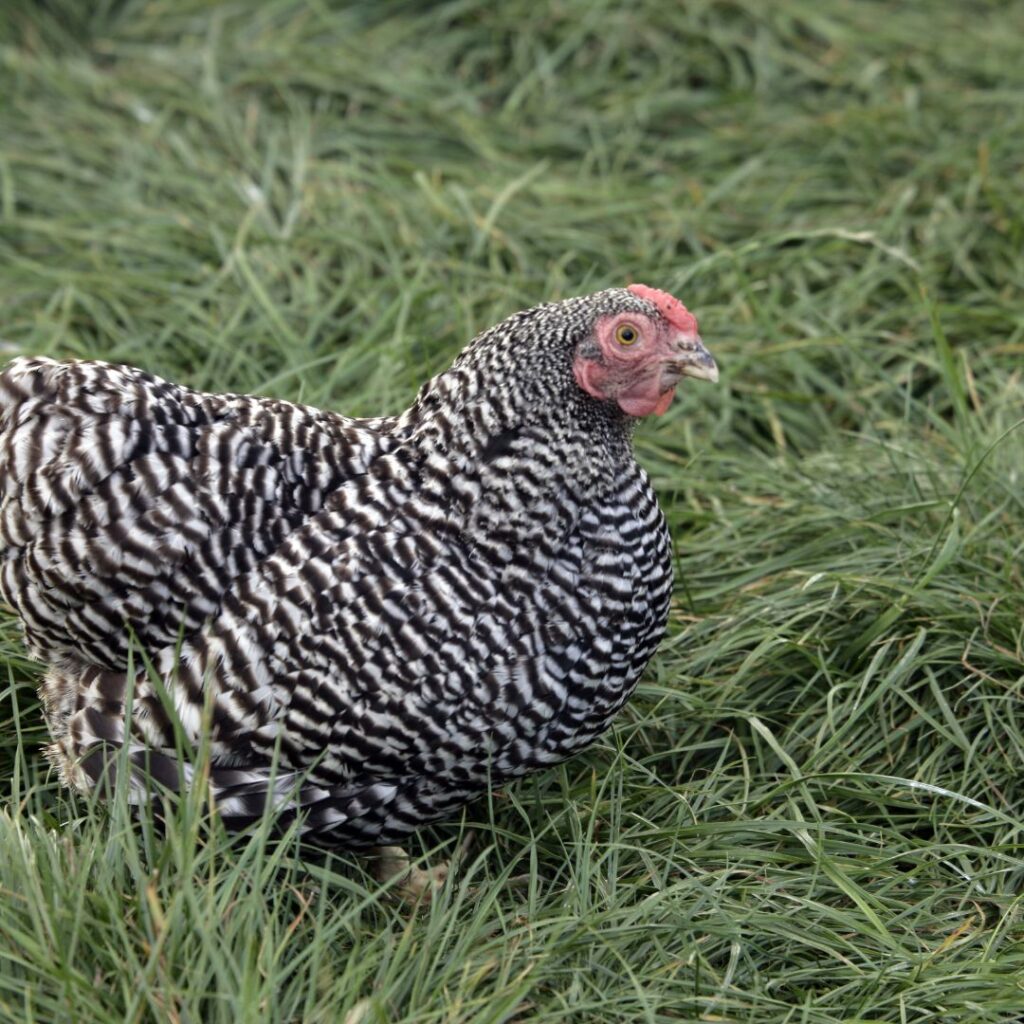
Is The Golden-Laced Wyandotte Chicken Noisy?
A Wyandotte chicken may have a reputation for being a fairly quiet bird, but don’t let that fool you. While their usual noise level is considerably low, these chickens can increase their volume when necessary – particularly when their personal space is limited.
In smaller enclosures or coops, Golden laced Wyandottes tend to make more noise as they assert themselves and defend their territory. It’s important to consider their potential volume when choosing housing for your flock. Providing ample space allows them to spread out and minimize potential noise levels. Maintaining a balanced habitat will create a happy and peaceful environment for the chickens and their human companions.
Are Golden-Laced Wyandotte Chickens Cold Hardy?
Wyandottes are quite resilient chickens and can withstand cold weather quite well. This makes them a great choice for farmers in colder climates who don’t want their egg production to suffer during winter.
Winter Chicken Coop Prep – Start by ensuring that the coop is well-ventilated to prevent a buildup of moisture, which can lead to frostbite or respiratory illness in chickens. Adding plenty of bedding, such as straw, also helps to insulate their living space and keep them warm.
In addition, check for any holes or cracks in the coop that may allow cold drafts to blow through – patching these up before winter sets in can make a big difference in keeping your chickens comfortable. These simple steps can help ensure that your chickens stay happy and healthy throughout the winter.
Winter Waterers – Wintertime presents unique challenges for chicken owners, particularly when keeping their flock’s water from freezing. Changing waterers can help prevent this, but an even better solution may be investing in a heated waterer or bowl warmer. These devices use electricity to keep the water at a comfortable drinking temperature for your chickens, eliminating the need for constant refills.
However, it’s important to remember that any source of electricity in the coop must be used with caution and appropriately protected from moisture to avoid any accidents or harm to your birds.
With careful consideration and planning, heated waterers or bowl warmers can provide a convenient and effective way to keep your chickens hydrated during the colder months.
Frostbite – When it comes to cold weather, not all breeds are created equal. The rose comb is a trait commonly found in Wyandottes, and it offers an advantage in frigid conditions. The tightly packed structure of the rose comb makes these chickens less prone to frostbite, allowing them to tolerate colder temperatures easily.
But even the hardiest breeds can suffer from frostbite if they become wet in freezing weather. Some chicken owners also use petroleum jelly to protect their birds’ combs and wattles.
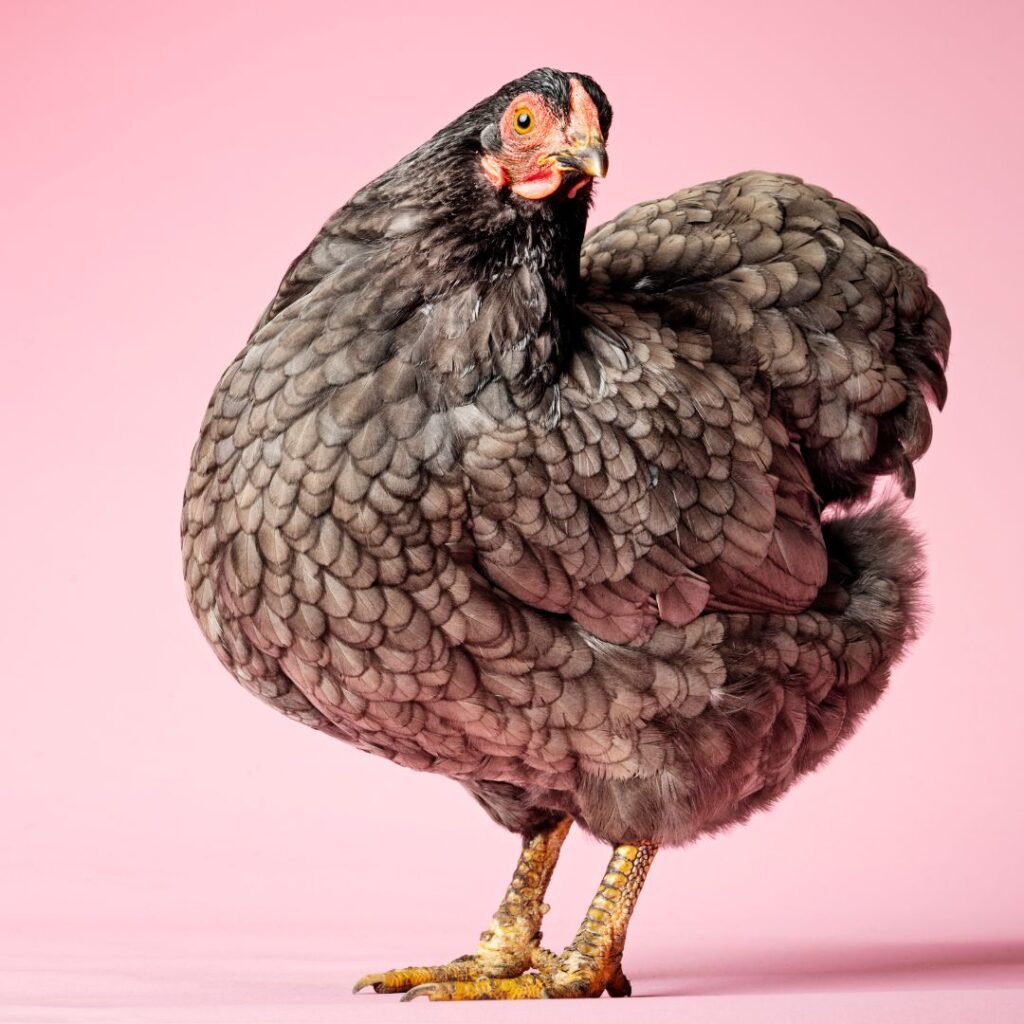
Life Expectancy of the Wyandotte Chickens
Wyandotte chicken Average life expectancy seems to range from 6-10 years. Being a strong and healthy bird, it’s not unheard of to have one live as long as 12 years.
Is The Wyandotte Chicken Right For Backyard Chicken Keepers?
The Wyandotte might be the perfect choice for your first chickens (read these tips for raising backyard chickens) for those just starting with backyard chickens. Poultry experts consider them excellent layers, producing plenty of large eggs throughout the year.
The Wyandotte chicken temperament allows them to hold their own in an established flock.
But that’s not all – these chickens are a true delight to watch and come in various beautiful colors, including silver and golden-laced varieties. Some chicken keepers consider their stunning plumage “eye candy” for their coops or yards.
Adding Wyandottes to your flock is a wonderful decision you won’t regret. They truly make a picturesque and productive addition to any backyard chicken set-up.
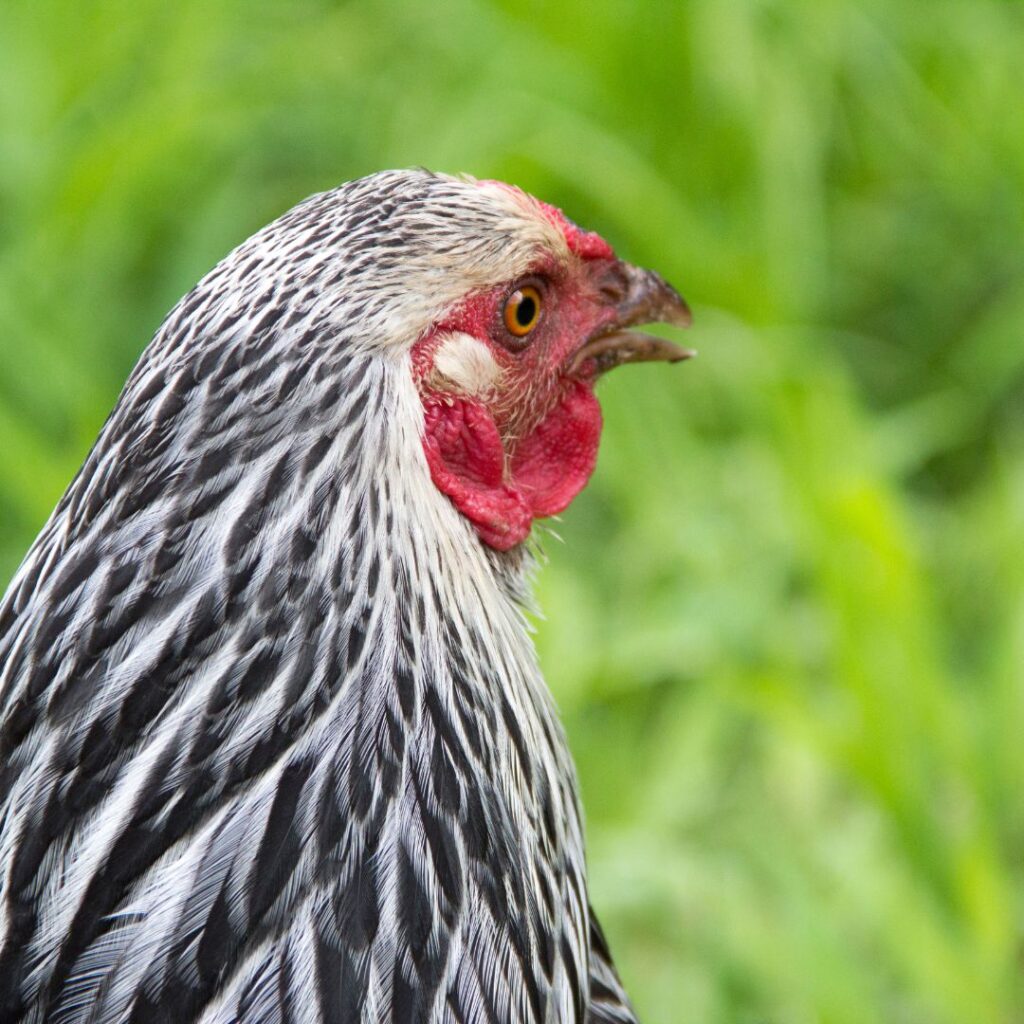
Take a moment to read about the prolific white egg layer (large – X-large eggs!), the White Leghorn and Blue Egg layers, the Araucana, Ameraucana, and Cream Legbar, and the famous Easter Egger, which lay rainbow-colored eggs. We’re sure you’ll enjoy these.


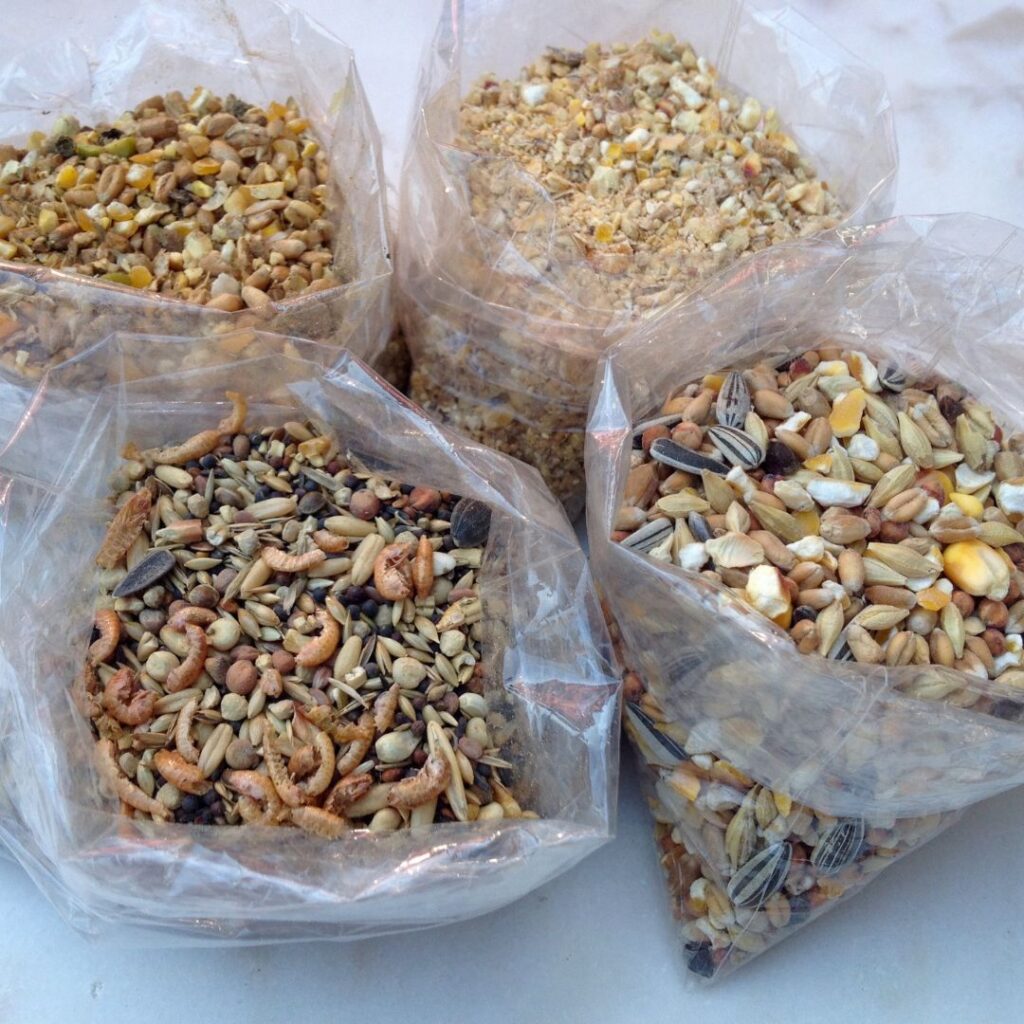

Pingback: Barred Plymouth Rock Chicken; All About the Plymouth Rock Chicken Breed
Pingback: French Black Copper Marans Chicken, About Eggs, Care, History
Pingback: 15+ Best Egg Laying Chicken Breeds; Qty, Color, Size Of Eggs